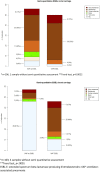Semi-quantitative cultures of throat and rectal swabs are efficient tests to predict ESBL-Enterobacterales ventilator-associated pneumonia in mechanically ventilated ESBL carriers
- PMID: 32313993
- PMCID: PMC7222166
- DOI: 10.1007/s00134-020-06029-y
Semi-quantitative cultures of throat and rectal swabs are efficient tests to predict ESBL-Enterobacterales ventilator-associated pneumonia in mechanically ventilated ESBL carriers
Abstract
Purpose: In ICU patients with carriage of extended spectrum beta-lactamase producing Enterobacterales (ESBL-E) and suspected Gram-negative bacilli ventilator-associated pneumonia (GNB-VAP), the quantification of the rectal and throat ESBL-E carriage might predict the ESBL-E involvement in GNB-VAP. Our aim was to evaluate whether a semi-quantitative assessment of rectal/throat ESBL-E carriage can predict ESBL-E-associated VAP in medical ICU patients.
Methods: From May 2014 to May 2017, all ESBL-E carriers had a semi-quantitative assessment of ESBL-E density in swabs cultures. For those who developed GNB-VAP (diagnosed using bronchoalveolar lavage or plugged telescopic catheter with significant quantitative culture), the last positive swab collected at least 48 h before GNB-VAP onset was selected. Clinical data were extracted from a prospectively collected database.
Results: Among 365 ESBL-E carriers, 82 developed 107 episodes of GNB-VAP (ESBL-E VAP, n = 50; and non-ESBL-E GNB-VAP, n = 57) after 13 days of mechanical ventilation in median. Antimicrobials use before VAP onset was similar between groups. The last swabs were collected 5 days in median before VAP onset. ESBL-E. coli carriers developed ESBL-E VAP less frequently (n = 13, 34%) than others (n = 32, 67.3%, p < .01). Throat swab positivity (39 (78%) vs. 12 (23%), p < .01) was more frequent for ESBL-E VAP. ESBL-E VAP was associated with significantly higher ESBL-E density in rectal swabs. In multivariate models, non-E. coli ESBL-E carriage and rectal ESBL-E carriage density, or throat carriage, remained associated with ESBL-E VAP.
Conclusion: In carriers of ESBL-E other than E. coli, ESBL-E throat carriage or a high-density ESBL-E rectal carriage are risk factors of ESBL-E VAP in case of GNB-VAP.
Keywords: Carbapenem; E. coli; Extended-spectrum beta-lactamase; Outcome; Sepsis; Ventilator-associated pneumonia.
Conflict of interest statement
All authors reported no conflict of interests for the submitted work. Outside of the submitted work, JFT reports research grants to my university from Merck, Pfizer, 3M. Lecture fees from Merck Biomerieux, Pfizer, Nabriva; fees for scientific board participation from Paratek, Merck, Bayer Pharma, Gilead.
Figures


References
-
- Torres A, Niederman MS, Chastre J, Ewig S, Fernandez-Vandellos P, Hanberger H, Kollef M, Li Bassi G, Luna CM, Martin-Loeches I, Paiva JA, Read RC, Rigau D, Timsit JF, Welte T, Wunderink R. International ERS/ESICM/ESCMID/ALAT guidelines for the management of hospital-acquired pneumonia and ventilator-associated pneumonia: Guidelines for the management of hospital-acquired pneumonia (HAP)/ventilator-associated pneumonia (VAP) of the European Respiratory Society (ERS), European Society of Intensive Care Medicine (ESICM), European Society of Clinical Microbiology and Infectious Diseases (ESCMID) and Asociacion Latinoamericana del Torax (ALAT) Eur Respir J. 2017;50:1700582. - PubMed
-
- Timsit JF, Bassetti M, Cremer O, Daikos G, de Waele J, Kallil A, Kipnis E, Kollef M, Laupland K, Paiva JA, Rodriguez-Bano J, Ruppe E, Salluh J, Taccone FS, Weiss E, Barbier F. Rationalizing antimicrobial therapy in the ICU: a narrative review. Intensive Care Med. 2019;45:172–189. - PubMed
-
- de Kraker ME, Jarlier V, Monen JC, Heuer OE, van de Sande N, Grundmann H. The changing epidemiology of bacteraemias in Europe: trends from the European Antimicrobial Resistance Surveillance System. Clin Microbiol Infect. 2013;19:860–868. - PubMed
-
- Zahar JR, Blot S, Nordmann P, Martischang R, Timsit JF, Harbarth S, Barbier F. Screening for intestinal carriage of ESBL-producing Enterobacteriaceae in critically ill patients: expected benefits and evidence-based controversies. Clin Infect Dis. 2018;68:2125–2130. - PubMed
-
- Pilmis B, Cattoir V, Lecointe D, Limelette A, Grall I, Mizrahi A, Marcade G, Poilane I, Guillard T, Bourgeois Nicolaos N, Zahar JR, Le Monnier A. Carriage of ESBL-producing Enterobacteriaceae in French hospitals: the PORTABLSE study. J Hosp Infect. 2018;98:247–252. - PubMed
MeSH terms
Substances
Grants and funding
LinkOut - more resources
Full Text Sources

